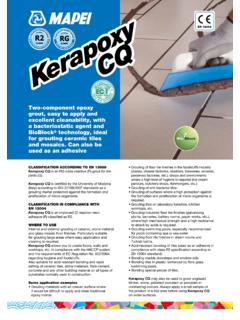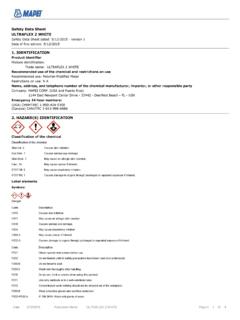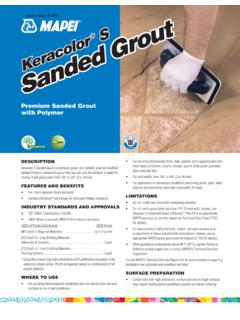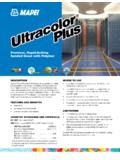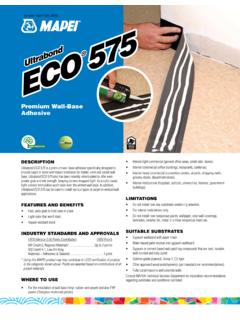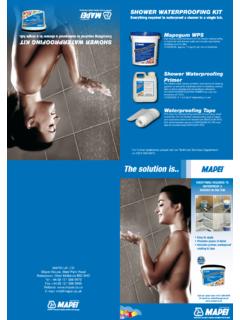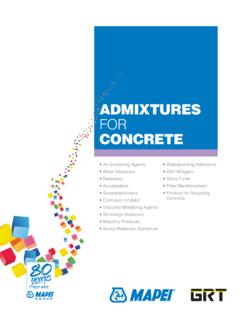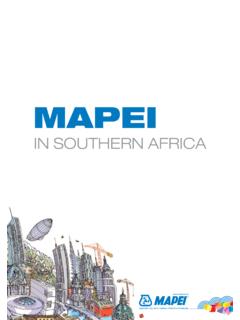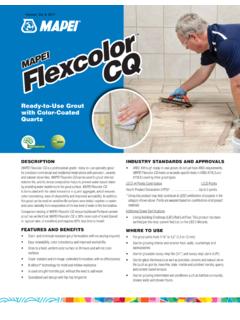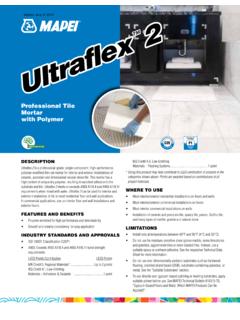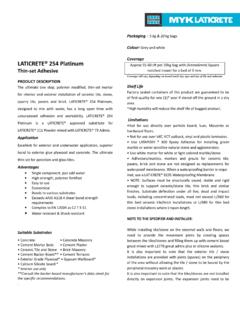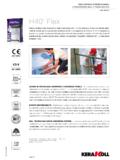Transcription of EN 12004 - Mapei
1 CLASSIFICATION ACCORDING TO EN 12004 elastorapid is a highly deformable (S2), improved (2), fast-setting (F) cementitious (C) adhesive, slip-resistant (T) and with extended open time (E), classified as C2 FTE of elastorapid is declared in ITT certificate No. 25070277/Gi (TUM) and No. 25080024/Gi (TUM) issued by the Technische Universit t M nchen laboratory (Germany).WHERE TO USEB onding to internal and external walls and floors of all types and sizes of ceramic tiles (single-fired, double-fired, porcelain, clinker, terracotta, etc.), natural stone (marble, granite, etc.) and artificial materials which are slightly sensitive to humidity (class B Mapei dimensional stability standard) which require the use of a fast-drying application examples Laying ceramic and stone floor coverings which are subject to intense traffic.
2 Quick repair operations where the floor needs to be put into service immediately (public buildings, motorway service areas, supermarkets, airports, pedestrian areas), even during hot weather. Compared with other fast-setting adhesives, the longer pot-life of elastorapid makes it more easy to apply even during hot weather. Laying tiles on deformable substrates: marine plywood, wooden agglomerates (if sufficiently stable to water), old wooden floors, etc. Quick laying or repair of tiled finishes in places such as swimming pools, refrigeration units, industrial plants (breweries, wine cellars, dairies etc.). Laying even large-sized ceramic and stone tiles on fa ades, balconies, terraces, and sun-roofs and patios which are subject to direct sunlight and thermal gradients.
3 Laying tiles in areas subject to high mechanical stresses and vibration (railway underpasses, underground railway platforms, etc.). Laying tiles on concrete substrates and pre-cast walls. Laying large-format tiles on heated screeds or on top of existing floor coverings in ceramic, terrazzo, marble, etc. Laying tiles on surfaces waterproofed with Mapelastic or Mapegum WPS. Laying stone material which is sensitive to stains (white Carrara, etc.).TECHNICAL CHARACTERISTICSE lastorapid is a two-component adhesive available in grey or white consisting of a special binder and selected silica sand (comp. A) and a synthetic latex rubber (comp. B).When the two components are mixed together, a mortar with the following characteristics is obtained: low viscosity, therefore easy to apply;ElastorapidElastorapidEN 12004 Two-component, high performance, highly-deformable, quick-setting and drying cementitious adhesive with no vertical slip and extended open time for ceramic tiles and stone material[Ceramica] 115_elastorapid_gb ( - 2 Bozza/Ciano/PDF) IN COMPLIANCE WITH EUROPEAN STANDARDS CEMENTITIOUS ADHESIVE FOR CERAMIC TILES EN 12004C2 FTES2best to use a low-speed mechanical mixer to obtain a smooth, homogenous paste by pouring the powder (component A) into the latex (component B).
4 The pot life is approximately 60-75 minutes at +20 C, but higher temperatures may reduce this time considerably. Compared to other fast-setting adhesives, however, the longer open time of elastorapid means that it is easier to lay tiles even during hot the mixApply elastorapid on the substrate with a notched trowel. Use a trowel which guarantees that the adhesive is spread well on the back of the achieve a good bond, first spread a thin layer of elastorapid on the substrate using the smooth side of the trowel, and then immediately apply another layer to the thickness required with a notched trowel according to the type and size of the pieces of mosaic up to 5x5 cm, use a Mapei No. 4 or 5 trowel (consumption kg/m ).For normal ceramic coverings, a Mapei No. 5 trowel with a rhomboid notch is recommended (consumption kg/m ).
5 For uneven floors or surfaces or tiles with a ribbed back, a Mapei No. 6 trowel with a rhomboid notch is recommended (consumption 5-6 kg/m ).For very uneven surfaces or with large tiles and tiles with large ribs on the back, a Mapei No. 10 trowel with a square notch is recommended (consumption 8 kg/m ) or a trowel used for Kerafloor (up to 1 cm thickness).For laying ceramic or natural stone on floors externally, tiles with a dovetail or knobbled back, tiles larger than 900 cm , floor coverings to be polished on site or subject to heavy loads or for swimming pools and water basins, spread the adhesive also on the back of the tile to guarantee full the tilesIt is not necessary to wet the tiles before laying them. Only when the backs are very dusty it is advisable to dip the tiles in clean tiles must be laid by pressing them down firmly to ensure a good contact with the normal climatic conditions, the open time of elastorapid is approximately 30 minutes.
6 Under unfavourable weather conditions (strong, direct sunlight, wind, high temperature and low ), or if the substrate is very absorbent, the open time may be reduced to only a few the substrate before applying the adhesive helps to increase the open constantly to make sure that the adhesive does not form a surface skin and that it is still fresh. If a surface skin forms, re-spread the adhesive with a notched trowel. Do not wet the adhesive if a surface skin forms. Instead of dissolving the skin, a non-adhesive skin will tiled with elastorapid must not be washed down or exposed to rain for at least 3-4 hours and must be protected from strong, direct sunlight for at least 12 AND SEALINGThe joints between the tiles may be grouted after 3 hours with a suitable Mapei highly thixotropic: elastorapid may be applied on vertical surfaces without sagging, and even large-sized, heavy tiles do not slip.
7 Tiles may be laid starting from the top of the surface without using spacers; the pot-life of the mix is particularly long compared with other fast-setting adhesives, making the laying operation easier even during the summer at high temperatures; good capacity for accomodating deformation of the substrate and tiles (chipboard, marine plywood, concrete, etc.); perfect bonding to all materials normally used in building; thicknesses of up to 10 mm set without shrinkage and without a reduction in thickness, until a considerably high mechanical strength is has high bonding strength after only 2-3 hours and, therefore, floor and wall coverings may be put into service very not use elastorapid : on metallic, rubber, PVC or linoleum surfaces; with marble or artificial materials which are subject to high levels of moisture movement (green marble, some types of slate and sandstone in the class C Mapei dimensional stability standard).
8 In this case, use Keralastic, Keralastic T or not add water or component B to the mixture that has begun to PROCEDUREP reparing the substrateThe substrates must be flat, stable, mechanically strong, sufficiently dry and free from loose or crumbly parts, grease, oil, paint, and wax, etc. Damp substrates may slow down the setting of substrates must not be subject to shrinkage after laying the tiles and therefore, during good weather, the substrates must be cured for at least 1 week per centimetre of thickness. Cementitious screeds must be cured for at least 28 days, unless they are made using a Mapei special binder for screeds such as Mapecem, Mapecem Pronto, Topcem or Topcem with water to cool down surfaces which are too hot due to exposure to direct substrates and anhydrite screeds must be perfectly dry ( max.)
9 Residual moisture ), sufficiently hard and free of dust. They must be treated with Primer G or Eco Prim T, while areas subject to high humidity must be treated with Primer general, refer to the relative Mapei technical documentation regarding substrate preparation before repairing cracks in substrates, consolidating rapid-drying screeds and levelling installation of the mixMix 25 kg of grey or white component A (cementitious powder) with kg of component B (synthetic latex rubber). It is ElastorapidElastorapidSpreading elastorapid on a cementitious screed with a notched trowelLaying porcelain tiles on a screed waterproofed with MapelasticLaying porcelain tiles on a marine plywood substrate with ElastorapidTECHNICAL DATA (typical values)In compliance with the norms: EN 12004 , such as C2 FTES2 ISO 13007-1 such as C2 FTES2 PRODUCT IDENTITYCOMPONENT A:Consistency:grey or white powderBulk density (kg/m ):1,250 Dry solids content (%):100 COMPONENT B:Consistency:liquidColour:whiteDensity (g/cm ):1,035 solids content (%):31 APPLICATION DATA (at +23 C and 50% )Mixing ratio:white: component A: 25 kg + part B: kg grey: component B: 25 kg + part B: kgConsistency of mix:thick pasteDensity of mix (kg/m ):1,650pH of mix:approx.
10 11 Application temperature range:from +5 C to +30 CPot life:60-75 minutesOpen time (according to EN 1346): 30 minutesSetting time:120-150 minutesTime to grouting:after 3 hoursSet to light foot traffic:after 3 hoursReady for use:after 24 hours (3 days for swimming pools and basins)FINAL PERFORMANCESB onding strength according to EN 1348 (N/mm ): initial (after 28 days): after heat ageing: after immersion in water: after freeze/thaw strength (N/mm ) after 28 strength (N/mm ) after 28 to acids:poorResistance to alkalis:excellentResistance to oil:excellentResistance to solvents:excellentService temperature range:from 30 C to +90 CDeformability according to EN 12002:S2 - highly deformableLaying large-sized porcelain tiles on a concrete fa ade with Elastorapidcementitious or epoxy grout, which is available in a variety of joints must be sealed with a suitable Mapei surfaces may be polished after 24 TO LIGHT FOOT TRAFFICF loors are set to light foot traffic after 3-4 FOR USEThe surfaces are ready for use after approximately 24 and swimming pools can be filled after 3 may be cleaned with clean water before the adhesive sets.
